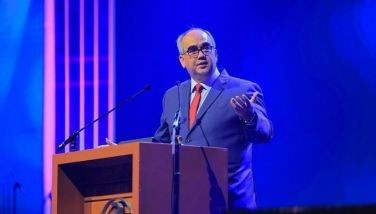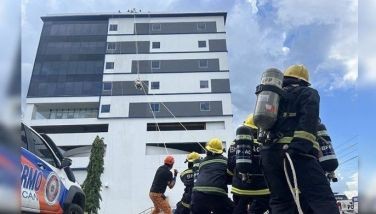Bridging progress
The President’s Bridge Program (PBP) is a parallel intervention to fast-track the provision of critical infrastructure development support to address the country’s ballooning bridge requirement of about 15,000 or about 200,000 lineal meters of local and national bridges as reflected in the Medium-Term Philippine Development Plan.
Annually, the Philippines has to deal with 22 to 27 typhoons or natural calamities destroying or weakening some 10,000 lineal meters of existing bridges. Even if foreign donor countries can supply an average of 20,000 lineal meters of bridges, there is still some 170,000 lineal meters of bridging required to be urgently constructed based on the 1994 NEDA approved master plan of bridges.
To link the remotest and poorest communities with the nation’s road network and highly urbanized centers is to create an opportunity of spreading the fruits of economic progress to the greatest number of the populace.
Since 1986, the PBP has been connecting our most remote places to the rest of the country. The President’s Bridge Program has been one of the major infrastructure development initiatives since the time of President Ramos through the use of official Development Assistance. More than 1,300 bridges have been constructed under the PBP that have dramatically contributed to the growth of communities in far-flung areas.
The PBP also boosted peace and order efforts in Mindanao as 89 bridges called Salam (peace) Bridge Project or Bridges for Peace were built in four war-torn ARMM provinces. There were also 593 bridges called Bridges of Hope erected in Mindanao and Palawan.
The program has been made possible through concessional loans from foreign governments. Funding initially came from the United Kingdom and expanded to include the governments of Austria, Spain, Korea and Japan.
All PBP projects pass through assessment and approval by the National Economic and Development Authority Investment Coordinating Committee (NEDA-ICC).
The project then goes to the Department of Finance and the Monetary Board for approval. Once approved, the Department of Justice does a final review before final approval.
Under the present administration, the Secretary of the Public Works and Highways leads the oversight committee that oversees the implementation of the project with ex-officio members composed of the Secretaries of the Departments of Finance, Foreign Affairs, Socio-Economic Planning, Public Works and Highways and Interior and Local Government. The Commission on Audit assists the committee to ensure that there is transparency and accountability.
The PBP’s pioneer contractor UK-based Mabey & Johnson, Ltd (M&J) uses an advanced bridging technology that features modular steel bridges that last for up to 100 years with little or no maintenance. This is easy to install as one pre-fabricated bridge can be put together in four days.
M&J is the supplier of bridges to Britain’s Armed Forces and international organizations such as the United Nations and the North Atlantic Treaty Organization. M&J built more than 1,200 bridges from Cagayan and Ilocos Norte in the north, to Tawi-Tawi in the south. An unfortunate ending happened to M&J when it was forced to shut its operations in the country due to an unforseen event.
Despite huge successes in the Philippines, M&J was found to have some issues in three out of the 114 countries it had served. The UK government inquired into alleged irregularities of the project, but to date the firm was found only to have done irregular business in Iraq, Jamaica and Ghana. The projects were pre-terminated by the Philippine government after a settlement agreement with M&J.
Under the settlement agreement the project will be able to complete an additional 64 spans of bridges. Implementation schedule under the settlement agreement is from July 2010 – December 2011.
During this period, COA responding to various anonymous complaints (dated 2005 and 2010) concluded in 2009 and 2011 that COA found no irregularities in any of the projects under PBP.
DAR requested M&J to reconfigure substructure materials to additional bridging materials through modification of settlement agreement.
The modification of the settlement agreement is currently being processed by M&J by realigning H-piles and civil works fund to additional bridging materials, which will increase the number of compact 200 bridges from 64 to approximately 120 bridges. Proposed implementation schedule is January 2011 – June 2013.
DAR decided to modify the original settlement agreement with the objective of optimizing the utilization of the delivered materials/goods and corresponding services as possible emergency response action in calamity stricken areas which need immediate restoration works on damaged bridge structures.
What was signed on June 28, 2010 was not a contract. It was a settlement agreement as a result of about two years of negotiation with British supplier M&J, as guided by Serious Fraud Office (SFO).By said settlement, the Philippines did not incur any obligation or additional cost. Instead, it gained additional bridge materials, avoided huge legal fees, unnecessary international dispute, and negative credit rating in Europe. The Philippines can further build 64 spans of bridges.
But despite the headway achieved in the PBP since 1986, some 15,000 bridges or 200,000 of lineal meters still have to be constructed all over the Philippines in order to link the many communities in this nation of 1,707 islands. Add to this the fact that the country has to deal with at least 22 typhoons every year that destroy or weaken existing bridges.
One has to wonder why despite the huge backlog in the PBP, a lawmaker still wants to dip his hands into the issue and has set his sights on probing the contract PBP entered into with British firm Mabey & Johnson (M&J).
Although M&J was probed in the UK for other deals with other foreign countries, this investigation of the M&J seems useless. In 2008, the COA even praised M&J and the PBP projects for incurring no cost overruns. These are the PBP Tulay ng Pangulo sa Barangay-Mabey Johnson, Countrywide Bridges Program (SZOPAD)-Mabey Johnson, Tulay ng Pangulo sa Kaunlaran- Mabey Johnson, the Urgent Bridges Development Project for Rural Development, and the Metro Cebu Development Project.
For comments, email at philstarhiddenagenda@yahoo.com
- Latest
- Trending

























